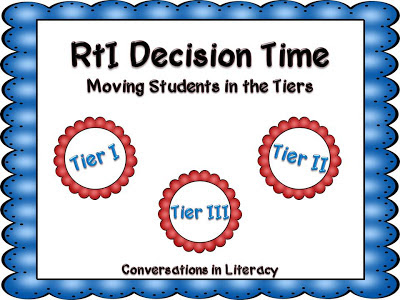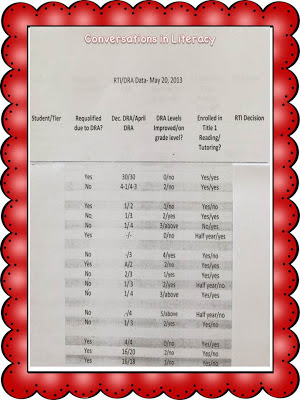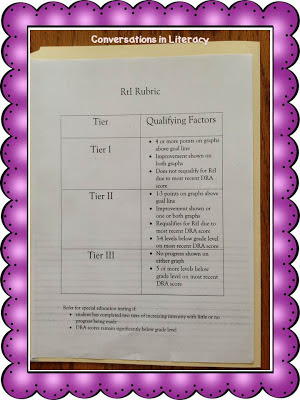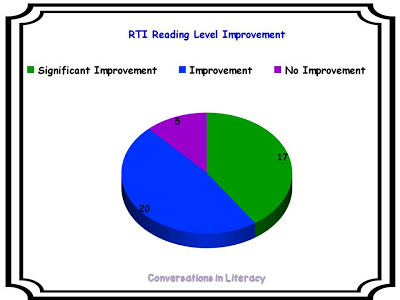Last week was our Decision Meeting for RtI. We have this all member committee meeting twice a year- once in January and once in May. We hold it after our RtI cycle has been completed.
A quick review of our RtI process is students are universally screened using the DRA 2 reading kit. I also screen kindergartners on phonemic awareness and letter/sound identification. Those students not reaching benchmarks are automatically placed into RtI groups. As head of our RtI committee, I place students by grouping them with others of similar needs: similar reading levels, similar areas of low skills, intervention needs, etc…
Students that are in Tier I stay within the classroom to work on areas of need or for enrichment. Tiers II and III go out to work in small groups (Tier II) or one on one (Tier III). Tier II for us is about 10 weeks long and Tier III lasts for about 12 weeks.
Each student starts with 2 and only two interventions to work towards mastering. When a skill is mastered, the student moves on to the next skill.
At the end of the cycle, I have scheduled classroom teachers to come to our meeting (one classroom teacher at a time) to meet with the committee. We discuss the progress made by the student, the RtI teacher talks about how the student performed for them, and the classroom teacher gives us input as to how the student is now doing in class. Then we look at the data:
* what was the student’s DRA score before RtI and after?
* was there any improvement in that DRA score?
* are they now on grade level?
* did their weekly progress graph show improvement?
* do they have other supports: Title 1, Reading Recovery, tutoring, etc…
You can click here to read my post and see the graph we use to show the results of weekly progress monitoring.





I wish I understood the RTI process as well as you. Your system seems so efficient. I'm always impressed when you explain all that you do for your kids!
❀ Tammy
Forever in First
Your schools' system seems VERY efficient. We do RTI in a similar fashion, but our graphs are just a little different. I love how you focus on the k-2 to try and catch and improve students early. Thanks for sharing all of this valuable information!
Amelia
wherethewildthingslearn
I love your rubric! I have a few more questions about how you determine interventions…how many intervention teachers are there? Do classroom teachers provide intervention? What will happen to the five students that didn't make progress?
I could talk to you all day about this post!!!! We are going to try the Walk-to Intervention Model next year. I'm trying to get as familiar as possible with it!! We do not use DRA, but we do have a phonics screener and a phonological awareness screener that we use.
Next school year, we will be required to provide 60% of interventions to K-2, and the remaining 40% to 3-5. I'm all for that, but I REALLY believe that struggling readers in 3-5, still need to receive intervention (we will figure out something).
At our school, one of our biggest challenges is mobility, and when we get students in the 4th grade that are so far behind, it just breaks my heart!! I feel that we are super effective (for the most part) with our K-2 interventions, but we struggle with older students more!
Bridget
Literacy Without Worksheets
I'm not at all familiar with RTI, but it sounds like your school is so fortunate to have you as their reading interventionist. You sound very caring AND organized!!
Grade ONEderful
Ruby Slippers Blog Designs
Lori- I'm so glad you did this post! We are moving toward focusing more on the K-2 students as well to try to have less needing services in the upper grades. Your RTI decision making process is so very organized- I think we need to start with a rubric at our school to get everyone on the same page. One question- you said the interventions are either 10 weeks or 12 weeks- do you follow certain programs for those weeks or is that just that the students are working toward their specific goals with a reading specialist/intervention group? I'm pinning this to refer back to over the summer to help get a little more organized for our school's RTI interventions! 🙂
Aylin
Learning to the Core
We are going to be starting RTI next year. This is very helpful and I will be checking back often for more advice! Thanks!! I would love for you to join my weekly linky-Tackle It Tuesday with Common Core. Your ideas are perfect! I hope to see ya soon!
Amy
3 Teacher Chicks
Thank you Tammy! It has taken us a few years to get out RtI to where it is so efficient. 🙂
Ameila, we have found that putting our focus on K-2 for RtI has really helped. And it is much easier to help them at a younger age. Thanks for visiting!
Bridget, I will try to answer your RtI questions without being too long. 🙂 We don't have a lot of intervention teachers, but we split our intervention times to help. We do K-2 at one time and then grades 3-5 at another 30 minute time. I use some of our aides to go into classrooms to do tier I so the classroom teachers can come out to help with tier II groups. Staffing, at least for us, is always a problem. When students don't make progress, they move up to Tier III for more intensive help. If they still do not make progress, we consider whether they should be referred for testing to see if there is a problem and if they qualify for special ed. We don't have to do this too often. You are welcome to email me if you want to talk more about RtI. I love talking about it too. 🙂
Thank you Barbara, I try to keep our RtI organized. It can be a big job sometimes. 🙂
Aylin, we do not follow any specific programs for RtI. I go through all of the DRA scores and phonemic awareness assessments and determine what gaps the students have. Then I group them in as similar of groups as I can to work on interventions that address those gaps. Good luck with your RtI process. And it is just that- a process that you work through trying to find what works for your students and staff. Takes a while to get it where you want it and you are always trying to improve it and make it better. 🙂
Thank you Amy! I hope that the RtI post helped you and maybe gave you some ideas. Thanks for the linky- I got linked up!